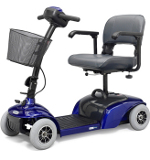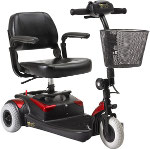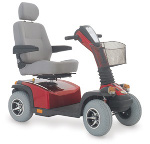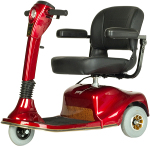The Wheelchair Guide
Your Wheelchair and Mobility Scooter Resource
A Closer Look at the Mobility Scooter
Saturday, December 26th, 2009
 Mobility scooters are not exactly new devices and have been around for some time, with the first models first being developed around forty years ago. Up until the nineteen-eighties the cost of mobility scooters, and for that matter electric wheelchairs, was often rather prohibitive, making the device not as common. However, due to increased competition and improved manufacturing techniques, mobility scooters are relatively inexpensive today and are extremely popular among the elderly.
Mobility scooters are not exactly new devices and have been around for some time, with the first models first being developed around forty years ago. Up until the nineteen-eighties the cost of mobility scooters, and for that matter electric wheelchairs, was often rather prohibitive, making the device not as common. However, due to increased competition and improved manufacturing techniques, mobility scooters are relatively inexpensive today and are extremely popular among the elderly.
A mobility scooter is a motorized device that is used to carry a single person around their home or as they complete daily activities. Using rechargeable batteries, many mobility scooters are able to support an individual weighing more than 300 pounds over distances exceeding 10 miles on a single charge.
Differences Between Electric Wheelchairs and Mobility Scooters
The function and manufacture of mobility scooters is actually quite similar to that of an electric wheelchair, but the actual design of these two devices is usually quite different.
Since an electric wheelchair is intended for constant use by its owner, it is designed so that it can be driven directly up to a table or desk, with its captain’s chair being positioned atop a small plastic base.
Mobility scooters, on the other hand, are designed more as a walking supplement and are usually used by those who are able to walk on their own for short periods of time. So, a much longer plastic base is used, with a set of handlebars extending from the front of the base.
The handlebars, or tiller as it is usually referred to, make it impossible for a mobility scooter to be driven directly up to a table or desk in the same manner as a wheelchair could be. They also usually contain headlights, turn signals, and other gauges to indicate things like battery strength.
Due to the larger wheelbase of a mobility scooter in relation to an electric wheelchair, they are often better suited for uneven terrain and outdoor conditions.
Types of Mobility Scooters
There are actually quite a few different types of mobility scooters. There are a number of ways to classify them, such as by their range and weight capacity, as well as their intended use.
One of the most common ways to differentiate between different types of mobility scooters is by classifying them as travel scooters, heavy duty scooters, and traditional scooters.
Travel Scooters are designed so that the scooter can be easily disassembled into more manageable pieces. As the name implies, this can make it much easier to travel with, as there is no need for a vehicle scooter lift and often the heaviest piece weighs around thirty pounds, so most people can lift the scooter into their trunk without difficulty. Of course, travel scooters have fewer features and are less durable, as they are instead designed to save weight.
Heavy Duty Scooters are designed for rugged outdoor use and to support a great deal more weight, often well over 500 pounds. They also have a much higher top speed and range than other scooters, as well as being better suited for outdoor conditions. This includes reinforced bumpers, larger wheels, more comfortable seats, and a wider wheelbase. However, due to their size, transporting a heavy duty scooter usually requires a scooter carrier and they may not work as well in the tight corners of a home.
Traditional Scooters fall in between travel scooters and heavy duty scooters. They usually include more features and can often be disassembled, but the individual pieces are heavier than a travel scooter. They also usually have a larger per-charge range and weight capacity than a travel scooter would, while being less than that of a heavy duty scooter.
The Importance of the number of Wheels
The number of wheels an adult scooter has is also used to classify the scooter and can determine what type of activities it is best suited for.
For outdoor use, a four wheel scooter is usually the best choice, as it is more stable and able to provide better weight support. Most heavy duty scooters are four wheeled, as this provides better stability.
A three wheel scooter will typically be more maneuverable, as it has a smaller wheel base, making it a good choice for indoor use. Many travel scooters will use a three wheel design as this makes it lighter as well. In general, an electric scooter with three wheels has a much smaller turning radius, which also causes it to be less stable.
The Different Types of Mobility Scooters
Monday, July 20th, 2009
For seniors and others who have difficulty walking around, the mobility scooter has been a powerful asset for some time. The first mobility scooters where developed about fifty years ago, but they really did not become practical or popular until the 1980′s.
Today, there are a number of different kinds of mobility scooters available, but they can basically be broken down into three distinct categories: Travel Scooters, Heavy Duty Scooters, and Traditional Scooters. Knowing the difference between these types of mobility scooters is very important, because they each offer their own advantages and disadvantages.
Travel Scooters
 Travel scooters are very popular, because they are lightweight and can be easily disassembled into several easy to manage pieces. Usually, the heaviest piece will weigh less than 30 pounds, so they can be easily picked up and placed in the trunk of a car, stored on a plane, or even placed into the backseat of a vehicle. Many travel scooter are also very easy to take apart and feature clasps that can be operated while only using a single hand. Since these types of scooters can be so easily transported, they can make them a great tool for going to an amusement park or visiting a new city.
Travel scooters are very popular, because they are lightweight and can be easily disassembled into several easy to manage pieces. Usually, the heaviest piece will weigh less than 30 pounds, so they can be easily picked up and placed in the trunk of a car, stored on a plane, or even placed into the backseat of a vehicle. Many travel scooter are also very easy to take apart and feature clasps that can be operated while only using a single hand. Since these types of scooters can be so easily transported, they can make them a great tool for going to an amusement park or visiting a new city.
While travel scooters can be very easy to transport, their lightweight comes at the cost of reduced functionality and stability. They are often not able to support as much weight, nor will a travel scooter fair as well over rougher terrain. Also, travel scooters are basically stripped of all extra features, to help reduce weight, including having a reduced per-charge range.
Travel Scooters Typically Cost: $800 – $1500
Heavy Duty Scooters
 Heavy Duty Scooters are pretty much the exact opposite of travel scooters. A heavy duty scooter offers superior weight capacity and off road maneuverability. They feature reinforced frames and often include special bumpers for added protection. Larger off-road tires and improved ground clearance make heavy duty scooters able to be driven pretty much anywhere. These mobility vehicles also include a number of other features designed to improve comfort and usability, such as overstuffed captains chairs and upgraded suspension.
Heavy Duty Scooters are pretty much the exact opposite of travel scooters. A heavy duty scooter offers superior weight capacity and off road maneuverability. They feature reinforced frames and often include special bumpers for added protection. Larger off-road tires and improved ground clearance make heavy duty scooters able to be driven pretty much anywhere. These mobility vehicles also include a number of other features designed to improve comfort and usability, such as overstuffed captains chairs and upgraded suspension.
While heavy duty scooters are an excellent tool for those who need a higher weight capacity or want a scooter that can be driven off-road with confidence, they are fairly large in size. They also have a larger turning radius, so when combined with their large size, heavy duty mobility scooters might take up too much space to be used effectively inside of a home. Also, due to their size, a vehicle scooter carrier is required to transport them. Like other types of mobility scooters, a heavy duty scooter can be disassembled, however the individual pieces are much heavier, sometimes weighing over 100 pounds. It is also not as easy to disassemble as a travel scooter would be.
Heavy Duty Scooters Usually Cost: $1500 – $5000
Traditional Scooters
 Traditional scooters fall in between heavy duty scooters and travel scooters. They preform well inside of a home and can also be used over most outdoor surfaces, providing the surface is fairly well packed. They include a number of features, such as running lights, and typically have a per-charge range of around 8 – 10 miles. Traditional scooters provide a great deal more stability than a travel scooter and typically support more weight as well.
Traditional scooters fall in between heavy duty scooters and travel scooters. They preform well inside of a home and can also be used over most outdoor surfaces, providing the surface is fairly well packed. They include a number of features, such as running lights, and typically have a per-charge range of around 8 – 10 miles. Traditional scooters provide a great deal more stability than a travel scooter and typically support more weight as well.
While traditional scooters are very sturdy, they are not as well suited for rougher outdoor terrain or wet ground. These types of scooters can be taken apart as well, but the individual pieces are not as lightweight as a travel scooter, nor is a traditional scooter as easy to take apart. In most cases, a vehicle scooter carrier is required to transport these devices, as they take up much more space and are a good deal heavier than travel scooters.
Traditional Scooters Typically Cost: $1300 – $2500